Magenta
| Magenta | |
|---|---|
|
| |
| Hex triplet | #FF00FF |
| sRGBB (r, g, b) | (255, 0, 255) |
| CMYKH (c, m, y, k) | (0, 100, 0, 0) |
| HSV (h, s, v) | (300°, 100%, 100%) |
| Source | CSS Color Module Level 3 |
|
B: Normalized to [0–255] (byte) H: Normalized to [0–100] (hundred) | |
Magenta (/məˈdʒɛntə/) is variously defined as a purplish-red,[1] reddish-purple, or a mauvish–crimson color.[2] On computer screens, it is made by mixing equal amounts of blue and red.[3] On color wheels of the RGB (additive) and CMY (subtractive) color models, it is located midway between red and blue. It is the complementary color of green. It is one of the four colors of ink used in color printing and by an inkjet printer, along with cyan, yellow, and black, to make all the other colors. The tone of magenta used in printing is called "printer's magenta" (Magenta (CMYK)).
Magenta was first introduced as the color of a new aniline dye called fuchsine, patented in 1859 by the French chemist François-Emmanuel Verguin. Its name was changed the same year to magenta, to celebrate a victory of the French and Sardinian army at the Battle of Magenta on June 4, 1859, near the Italian town of that name.[4]
The web color magenta is also called fuchsia.
In optics and color science
Magenta is an extra-spectral color, meaning that it is not found in the visible spectrum of light. Rather, it is physiologically and psychologically perceived as the mixture of red and violet/blue light, with the absence of green.[5]
In the RGB color system, used to create all the colors on a television or computer display, magenta is a secondary color, made by combining equal amounts of red and blue light at a high intensity. In this system, magenta is the complementary color of green, and combining green and magenta light on a black screen will create white.
In the CMYK color model, used in color printing, it is one of the three primary colors, along with cyan and yellow, used to print all the rest of the colors. If magenta, cyan, and yellow are printed on top of each other on a page, they make black. In this model, magenta is the complementary color of green, and these two colors have the highest contrast and the greatest harmony. If combined, green and magenta ink will look dark gray or black. The magenta used in color printing, sometimes called process magenta, is a darker shade than the color used on computer screens.
A purple hue in terms of color theory, magenta is evoked by light having less power in green wavelengths than in blue/violet and red wavelengths (complements of magenta have wavelength 500–530 nm).[6]
In the Munsell color system, magenta is called red–purple.
If the spectrum is wrapped to form a color wheel, magenta (additive secondary) appears midway between red and violet. Violet and red, the two components of magenta, are at opposite ends of the visible spectrum and have very different wavelengths. The additive secondary color magenta, as noted above, is made by combining violet and red light at equal intensity; it is not on the actual spectrum.
 In the RGB color model, used to make colors on computer and television displays, magenta is created by the combination of equal amounts of blue and red light.
In the RGB color model, used to make colors on computer and television displays, magenta is created by the combination of equal amounts of blue and red light. In the RGB color wheel of additive colors, magenta is midway between blue and red.
In the RGB color wheel of additive colors, magenta is midway between blue and red.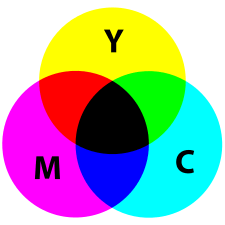 In the CMYK color model, used in color printing, cyan, magenta, and yellow combined make black. In practice, since the inks are not perfect, some black ink is added.
In the CMYK color model, used in color printing, cyan, magenta, and yellow combined make black. In practice, since the inks are not perfect, some black ink is added. Magenta is not part of the visible spectrum of light.
Magenta is not part of the visible spectrum of light.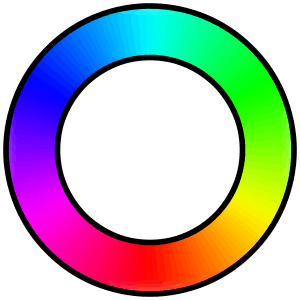 Visible spectrum wrapped to join violet and red in an additive mixture of magenta. In reality, violet and red are at opposite ends of the spectrum, and have very different wavelengths.
Visible spectrum wrapped to join violet and red in an additive mixture of magenta. In reality, violet and red are at opposite ends of the spectrum, and have very different wavelengths.
Fuchsia and magenta
In optics, fuchsia and magenta are essentially the same color. The web colors fuchsia and magenta are completely identical, and are made by mixing exactly the same proportions of blue and red light. In design and printing, there is a little more variation. The French version of fuchsia in the RGB color model and in printing contains a higher proportion of red than the American version of fuchsia. Fuchsia flowers themselves, which inspired both colors, have a variety of colors, from fuchsia to purple to red and pink.
Gallery
 The flower of Fuchsia plant was the original inspiration for the dye, which was later renamed magenta dye.
The flower of Fuchsia plant was the original inspiration for the dye, which was later renamed magenta dye.- Magenta took its name in 1860 from this aniline dye that was originally called "fuchsine", after the fuchsia flower.
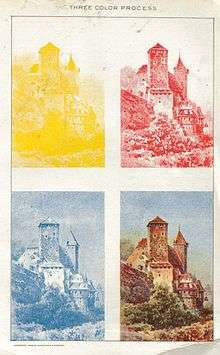 Magenta has been used in color printing since the late nineteenth century. Images are printed in three colors; magenta, cyan, and yellow, which when combined can make all colors. This image from 1902 is using the alternative RYB color model instead.
Magenta has been used in color printing since the late nineteenth century. Images are printed in three colors; magenta, cyan, and yellow, which when combined can make all colors. This image from 1902 is using the alternative RYB color model instead. Color printers today use magenta, cyan, and yellow ink to produce the full range of colors.
Color printers today use magenta, cyan, and yellow ink to produce the full range of colors. Magenta is the complementary color of green. The two colors combined in the RGB model form white. Side-by-side, they provide the highest possible contrast and reinforce each other's brightness.
Magenta is the complementary color of green. The two colors combined in the RGB model form white. Side-by-side, they provide the highest possible contrast and reinforce each other's brightness.
History
Fuchsine and magenta dye (1860)
The color magenta was the result of the industrial chemistry revolution of the mid-nineteenth century, which began with the invention by William Perkin of mauveine in 1856, which was the first synthetic aniline dye. The enormous commercial success of the dye and the new color it produced, mauve, inspired other chemists in Europe to develop new colors made from aniline dyes.[4]
In France, François-Emmanuel Verguin, the director of the chemical factory of Louis Rafard near Lyon, tried many different formulae before finally in late 1858 or early 1859, mixing aniline with carbon tetrachloride, producing a reddish-purple dye which he called "fuchsine", after the color of the flower of the fuchsia plant. He quit the Rafard factory and took his color to a firm of paint manufacturers, Francisque and Joseph Renard, who began to manufacture the dye in 1859.
In the same year, two British chemists, Chambers Nicolson and George Maule, working at the laboratory of the paint manufacturer George Simpson, located in Walworth, south of London, made another aniline dye with a similar red-purple color, which they began to manufacture in 1860 under the name "roseine". In 1860 they changed the name of the color to "magenta", in honor of the battle fought between the French and Austrians at Magenta, Italy the year before, and the new color became a commercial success.[4] Before printer's magenta was invented in the 1890s for CMYK printing, and electric magenta was invented in the 1980s for computer displays, these two artificially engineered colors were preceded by the color displayed at right, which is the color originally called "fuchsine" made from coal tar dyes in the year 1859. The name of the color was soon changed to "magenta", being named after the Battle of Magenta fought at Magenta, Lombardy-Venetia.[7]
Starting in 1935 the family of quinacridone dyes was developed. These have colors ranging from red to violet, so nowadays a quinacridone dye is often used for magenta. Various tones of magenta—light, bright, brilliant, vivid, rich, or deep—may be formulated by adding varying amounts of white to quinacridone artist's paints.
Another dye used for magenta is Lithol Rubine BK. One of its uses is as a food coloring.
Process magenta (pigment magenta; printer's magenta) (1890s)
| Process magenta (subtractive primary, sRGB approximation) | |
|---|---|
| Hex triplet | #FF0090 |
| sRGBB (r, g, b) | (255, 0, 144) |
| CMYKH (c, m, y, k) | (0, 100, 0, 0) |
| HSV (h, s, v) | (320°, 100%, 100%) |
| Source | CMYK |
|
B: Normalized to [0–255] (byte) H: Normalized to [0–100] (hundred) | |
In color printing, the color called process magenta, pigment magenta, or printer's magenta is one of the three primary pigment colors which, along with yellow and cyan, constitute the three subtractive primary colors of pigment. (The secondary colors of pigment are blue, green, and red.) As such, the hue magenta is the complement of green: magenta pigments absorb green light; thus magenta and green are opposite colors.
The CMYK printing process was invented in the 1890s, when newspapers began to publish color comic strips.
Process magenta is not an RGB color, and there is no fixed conversion from CMYK primaries to RGB. Different formulations are used for printer's ink, so there may be variations in the printed color that is pure magenta ink. A typical formulation of process magenta is shown in the color box at right.
Web colors magenta and fuchsia
| Magenta (Fuchsia) | |
|---|---|
| Hex triplet | #FF00FF |
| sRGBB (r, g, b) | (255, 0, 255) |
| CMYKH (c, m, y, k) | (0, 100, 0, 0) |
| HSV (h, s, v) | (300°, 100%, 100%) |
| Source | X11 |
|
B: Normalized to [0–255] (byte) H: Normalized to [0–100] (hundred) | |
At right is the web color magenta. It is one of the three secondary colors in the RGB color model. On the RGB color wheel, magenta is the color between rose and violet, and halfway between red and blue.
This color is called magenta in X11 and fuchsia in HTML. In the RGB color model, it is created by combining equal intensities of red and blue light. The two web colors magenta and fuchsia are exactly the same color. Sometimes the web color magenta is called electric magenta or electronic magenta.
While the magenta used in printing and the web color have the same name, they have important differences. Process magenta (the color used for magenta printing ink—also called printer's or pigment magenta) is much less vivid than the color magenta achievable on a computer screen. CMYK printing technology cannot accurately reproduce on paper the color on the computer screen. When the web color magenta is reproduced on paper, it is called fuchsia and it is physically impossible for it to appear on paper as vivid as on a computer screen.
Colored pencils and crayons called "magenta" are usually colored the color of process magenta (printer's magenta) shown above.
In science and culture
In art
- Shades of magenta began to appear in art soon after it was introduced. Paul Gauguin (1848-1903) used a shade of magenta in 1890 in his portrait of Marie Lagadu, and in some of his South Seas paintings.
- Henri Matisse and the members of the Fauvist movement used magenta and other non-traditional colors to surprise viewers, and to move their emotions through the use of bold colors.
- Since the mid-1960s, water based fluorescent magenta paint has been available to paint psychedelic black light paintings. (Fluorescent cerise, fluorescent chartreuse yellow, fluorescent blue, and fluorescent green.)
 Magenta, along with mauve, made with the newly discovered aniline dyes, became a popular fashion color in the second half of the nineteenth century. It appeared in art in this 1890 work, Psyche, by Bouguereau.
Magenta, along with mauve, made with the newly discovered aniline dyes, became a popular fashion color in the second half of the nineteenth century. It appeared in art in this 1890 work, Psyche, by Bouguereau. Paul Gauguin, Portrait of Marie Lagadu (1890).
Paul Gauguin, Portrait of Marie Lagadu (1890).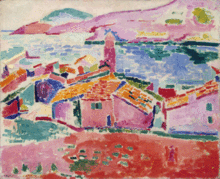 Henri Matisse, Les toits de Collioure (1905). Henri Matisse and the other painters of the Fauvist movement were the first to make a major use of magenta to surprise and make an impact on the emotions of the viewer.
Henri Matisse, Les toits de Collioure (1905). Henri Matisse and the other painters of the Fauvist movement were the first to make a major use of magenta to surprise and make an impact on the emotions of the viewer.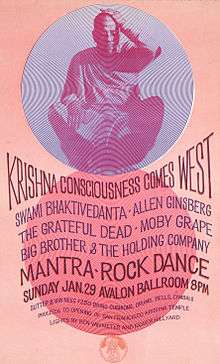 In the 1960s, magenta was a popular color in psychedelic art, such as this concert poster for the Avalon Ballroom in San Francisco (1967).
In the 1960s, magenta was a popular color in psychedelic art, such as this concert poster for the Avalon Ballroom in San Francisco (1967).
In astronomy
- Astronomers have reported that spectral class T brown dwarfs (the ones with the coolest temperatures except for the recently discovered Y brown dwarfs) are colored magenta because of absorption by sodium and potassium atoms of light in the green portion of the spectrum.[8][9][10]
 Artist's vision of a spectral class T brown dwarf
Artist's vision of a spectral class T brown dwarf
In biology: magenta insects, birds, fish, and animals
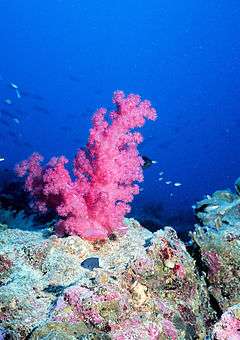 Coral from the Persian Gulf
Coral from the Persian Gulf An Andean flamingo, (Phoenicopterus andinus )
An Andean flamingo, (Phoenicopterus andinus ) A dragonfly, or Anisoptera Ana Cotta
A dragonfly, or Anisoptera Ana Cotta Pseudanthias tuka, a reef fish from the Indian Ocean.
Pseudanthias tuka, a reef fish from the Indian Ocean.
In botany
Magenta is a common color for flowers, particularly in the tropics and sub-tropics. Because magenta is the complementary color of green, magenta flowers have the highest contrast with the green foliage, and therefore are more visible to the animals needed for their pollination.
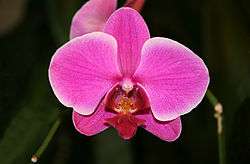 Orchid Phalaenopsis
Orchid Phalaenopsis- Clematis "Sunset"
.jpg) Cape primrose (Primulaceae)
Cape primrose (Primulaceae) Dahlia "Hillcrest Royal"
Dahlia "Hillcrest Royal" Rambler rose
Rambler rose Syringa "Paul Deschanel"
Syringa "Paul Deschanel"- Lily "Malinoviy Zvon"
- Polemoniaceae, or Phlox
 A cactus flower
A cactus flower Achillea "Staroe Burgundskoe"
Achillea "Staroe Burgundskoe"
In politics
- The color magenta is used to symbolize anti-racism by the Amsterdam-based anti-racism Magenta Foundation.[11]
- In Danish politics the magenta is the color of Det Radikale Venstre, the Danish social-liberal party.
See also
Notes and citations
- ↑ Webster's New World Dictionary of the American Language (1964)
- ↑ definition of magenta in Oxford dictionary (American English) (US)
- ↑ Christine E. Barnes (1 February 2011). The Quilter's Color Club: Secrets of Value, Temperature & Special Effects. C&T Publishing Inc. ISBN 9781607051664. Retrieved 27 July 2014.
- 1 2 3 Philip Ball (2001). Bright Earth: Art and the Invention of Color (illustrated ed.). University of Chicago Press. p. 214. ISBN 978-0226036281. Retrieved 27 July 2014. Originally referenced from French edition pages 311–312 ISBN 978-2754105033
- ↑ the auroran sunset, updated Xavier. "theory of colour: Orange is Tertiary". abelard.org.
- ↑ Bruce MacEvoy. "Light and the Eye", Handprint. A chart citing R.W.G. Hunt 2004. The Reproduction of Color.
- ↑ Maerz and Paul. A Dictionary of Color, New York:1930 McGraw-Hill Page 126 Plate 52 Color Sample K12–Magenta
- ↑ Brown Dwarves (go halfway down the website to see a picture of a magenta brown dwarf)
- ↑ Burrows et al. The theory of brown dwarfs and extrasolar giant planets. Reviews of Modern Physics 2001; 73: 719-65
- ↑ An Artist's View of Brown Dwarf Types (26 June 2002) Dr. Robert Hurt of the Infrared Processing and Analysis Center
- ↑ Magenta Foundation. Organization website.
External links
- Pictures of actual aniline dye samples in various shades of magenta.
- Magenta is a product of the brain rather than a spectral frequency
- Colour Mixing and the Mystery of Magenta, Royal Institution video